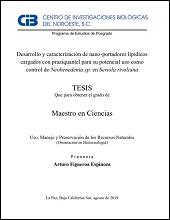| dc.contributor.advisor | Ascencio Valle, Felipe de Jesús | |
| dc.contributor.advisor | GALINDO RODRIGUEZ, SERGIO ARTURO | |
| dc.contributor.author | Figueroa Espinoza, Arturo | |
| dc.date.issued | 2019 | |
| dc.identifier.uri | http://dspace.cibnor.mx:8080/handle/123456789/3068 | |
| dc.description.abstract | "La piscicultura marina es un campo productivo de alto interés comercial. Particularmente, en México se cultiva el atún y el jurel. No obstante, las condiciones de los cultivos masivos, confinados en volúmenes reducidos promueven la llegada de infestaciones parasíticas, como es el caso de los problemas causados por la Clase Monogenea. Las medidas de control actuales consisten en baños con agua dulce o peróxido de hidrogeno, o bien con el uso de antihelmínticos como el praziquantel. Dicho fármaco con un alto efecto contra los monogéneos, sin embargo, su hidrofobicidad, farmacocinética y las propiedades organolépticas que presenta limitan su aplicación en el medio marino a cultivos de peces. Las nanopartículas lipídicas representan una alternativa viable para la administración de fármacos por la vía oral, protegiendo al fármaco y reduciendo la dosis administrada gracias a la liberación sostenida de sustancias incorporadas. El objetivo del presente trabajo fue desarrollar, caracterizar y evaluar una formulación de praziquantel incorporado a nanoportadores lipídicos. Utilizando la técnica de ultra-sonicación se obtuvieron nanopartículas de ácido esteárico y aceite de hígado de bacalao, con un diámetro de ~200 nm (PdI = 0.2 ±0.02; pZ = 30 ±2). La eficiencia de encapsulación del praziquantel en los nanoportadores lipídicos fue de 87 % ±3, calculada por la validación del método de cuantificación mediante espectrofotometría UV-Vis. La presencia del fármaco dentro los nanoportadores de comprobó mediante el análisis de FT-IR, mientras que la forma de la estructura fue observada con microscopia electrónica de barrido. La formulación fue incorporada a alimento comercial y se realizó un ensayo de aceptación por parte de jureles (Seriola rivoliana), del cual se obtuvieron resultados favorables administrando una dosis de 50 mgkg-1 PC, pero sin ninguna diferencia significativa entre el tratamiento de praziquantel encapsulado y el de praziquantel libre..." | es |
| dc.format | pdf | es |
| dc.language.iso | spa | es |
| dc.publisher | Centro de Investigaciones Biológicas del Noroeste, S.C. | es |
| dc.rights | Acceso abierto | es |
| dc.subject | Monogenea, Tratamiento, Acuicultura | es |
| dc.subject | Monogenea, Treatment, Aquaculture | es |
| dc.subject.classification | PISCICULTURA | es |
| dc.title | Desarrollo y caracterización de nano-portadores lipídicos cargados con praziquantel para su potencial uso como control de Neobenedenia sp. en Seriola rivoliana | es |
| dc.type | masterThesis | es |
| dc.dirtesis.grado | Maestría en Ciencias en el Uso, Manejo y Preservación de los Recursos Naturales | es |
| dc.dirtesis.disciplina | Biotecnología | es |
| dc.dirtesis.universidad | Centro de Investigaciones Biológicas del Noroeste, S.C. | es |
| dc.dirtesis.facultad | Posgrado en Recursos Naturales | es |
| dc.description.abstracten | "Marine fish farming is a productive field of high commercial interest. Particularly, in Mexico the genera Thunnus and Seriola are cultivated. However, the conditions of massive crops, confined in small volumes, promote parasitic infestations, as is the case of the problems caused by Monogenea. Current control treatments consist of baths with fresh water or hydrogen peroxide, or with the use of anthelmintic drugs such as praziquantel. This drug has a high effectivity against Monogenea, however, its hydrophobicity, pharmacokinetics and organoleptic properties limit the application to fish crops in the marine environment. Lipid nanoparticles represent a viable alternative for oral administration of drugs, protecting the drug and reducing the dose administered thus the sustained release of incorporated substances. The aim of this work was to develop, characterize and evaluate a formulation of praziquantel incorporated into lipid nanocarriers. Using the ultrasonication method, stearic acid and cod liver oil nanoparticles were obtained, with a diameter of ~ 200 nm (PdI = 0.2 ± 0.02; pZ = 30 ± 2). The encapsulation efficiency of praziquantel in lipid nanocarriers was 87 % ± 3, calculated by the validation of the quantification method by UV-Vis spectrophotometry. The presence of the drug within the nanocarriers was checked by FT-IR analysis, while the shape of the structure was observed with scanning electron microscopy. The formulation was incorporated into commercial food and an acceptance test was carried out with Seriola rivoliana fishes, which favorable results were obtained by administering a dose of 50 mgkg-1 BW, but without any significant difference between the treatment of encapsulated praziquantel and that of free praziquantel. The anthelmintic activity of the food produced for the palatability test was evaluated in vitro against monogenic parasites of the genus Neobenedenia extracted from infected fishes, the variables of surface shedding and eggs production(during 18 h) were observed to compare the treatments, the statistical analysis showed significant differences with respect to the eggs produced between treatments with praziquantel and those that did not contain the drug, it should be mentioned that there was no difference among the treatments of free praziquantel in seawater and encapsulated, which proves the effectiveness of the formulation..." | es |
| dc.audience | administrators | es |

